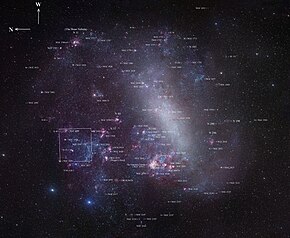
Back Groot Magellaanse Wolk Afrikaans سحابة ماجلان الكبرى Arabic سحابة ماجلان الكبيره ARZ Gran Nube de Magallanes AST Оло Магеллан Болото Bashkir Вялікае Магеланава Воблака Byelorussian Голям Магеланов облак Bulgarian বৃহৎ ম্যাগেলানিক মেঘ Bengali/Bangla Koumoulenn vras Magellan Breton Gran Núvol de Magalhães Catalan
| Large Magellanic Cloud | |
|---|---|
 A map of the Large Magellanic Cloud with the brightest features annotated | |
| Observation data (J2000 epoch) | |
| Constellation | Dorado/Mensa |
| Right ascension | 05h 23m 34s[1] |
| Declination | −69° 45.4′[1] |
| Distance | 163,000 light-years (49.97 kpc)[2] |
| Apparent magnitude (V) | 0.13[1] |
| Characteristics | |
| Type | SB(s)m[1] |
| Mass | 1×1010 (excluding dark matter), 1.38×1011[3] (including dark matter). M☉ |
| Number of stars | 20 billion[5] |
| Size | 9.86 kpc (32,200 ly)[1] (diameter; 25.0 mag/arcsec2 B-band isophote)[4] |
| Apparent size (V) | 10.75° × 9.17°[1] |
| Other designations | |
| LMC, ESO 56- G 115, PGC 17223,[1] Nubecula Major[6] | |
The Large Magellanic Cloud (LMC) is a dwarf galaxy and satellite galaxy of the Milky Way.[7] At a distance of around 50 kiloparsecs (163,000 light-years),[2][8][9][10] the LMC is the second- or third-closest galaxy to the Milky Way, after the Sagittarius Dwarf Spheroidal (c. 16 kiloparsecs (52,000 light-years) away) and the possible dwarf irregular galaxy called the Canis Major Overdensity. Based on the D25 isophote at the B-band (445 nm wavelength of light), the Large Magellanic Cloud is about 9.86 kiloparsecs (32,200 light-years) across.[1][4] It is roughly one-hundredth the mass of the Milky Way[11] and is the fourth-largest galaxy in the Local Group, after the Andromeda Galaxy (M31), the Milky Way, and the Triangulum Galaxy (M33).
The LMC is classified as a Magellanic spiral.[12] It contains a stellar bar that is geometrically off-center, suggesting that it was once a barred dwarf spiral galaxy before its spiral arms were disrupted, likely by tidal interactions from the nearby Small Magellanic Cloud (SMC) and the Milky Way's gravity.[13] The LMC is predicted to merge with the Milky Way in approximately 2.4 billion years.[14]
With a declination of about −70°, the LMC is visible as a faint "cloud" from the southern hemisphere of the Earth and from as far north as 20° N. It straddles the constellations Dorado and Mensa and has an apparent length of about 10° to the naked eye, 20 times the Moon's diameter, from dark sites away from light pollution.[15]
- ^ a b c d e f g h "NASA/IPAC Extragalactic Database". Results for Large Magellanic Cloud. Retrieved 29 July 2022.
- ^ a b Pietrzyński, G; D. Graczyk; W. Gieren; I. B. Thompson; B. Pilecki; A. Udalski; I. Soszyński; et al. (7 March 2013). "An eclipsing-binary distance to the Large Magellanic Cloud accurate to two per cent". Nature. 495 (7439): 76–79. arXiv:1303.2063. Bibcode:2013Natur.495...76P. doi:10.1038/nature11878. PMID 23467166. S2CID 4417699.
- ^ Erkal, Denis (2019). "The total mass of the Large Magellanic Cloud from its perturbation on the Orphan stream". Monthly Notices of the Royal Astronomical Society: Letters. 487 (2): 2685–2700. arXiv:1812.08192. doi:10.1093/mnras/stz1371.
- ^ a b De Vaucouleurs, Gerard; De Vaucouleurs, Antoinette; Corwin, Herold G.; Buta, Ronald J.; Paturel, Georges; Fouque, Pascal (1991). Third Reference Catalogue of Bright Galaxies. Bibcode:1991rc3..book.....D.
- ^ Steven J. Dick (21 March 2019). Classifying the Cosmos: How We Can Make Sense of the Celestial Landscape. Springer. ISBN 978-3-03-010380-4.
- ^ Buscombe, William (1954). "Astronomical Society of the Pacific Leaflets, The Magellanic Clouds". Astronomical Society of the Pacific Leaflets. 7 (302): 9. Bibcode:1954ASPL....7....9B.
- ^ Shattow, Genevieve; Loeb, Abraham (2009). "Implications of recent measurements of the Milky Way rotation for the orbit of the Large Magellanic Cloud". Monthly Notices of the Royal Astronomical Society: Letters. 392 (1): L21–L25. arXiv:0808.0104. Bibcode:2009MNRAS.392L..21S. doi:10.1111/j.1745-3933.2008.00573.x. S2CID 854729.
- ^ Cite error: The named reference
Macrietal2006was invoked but never defined (see the help page). - ^ Freedman, Wendy L.; Madore, Barry F. (2010). "The Hubble Constant". Annual Review of Astronomy and Astrophysics. 48: 673–710. arXiv:1004.1856. Bibcode:2010ARA&A..48..673F. doi:10.1146/annurev-astro-082708-101829. S2CID 119263173.
- ^ Majaess, Daniel J.; Turner, David G.; Lane, David J.; Henden, Arne; Krajci, Tom (2010). "Anchoring the Universal Distance Scale via a Wesenheit Template". Journal of the American Association of Variable Star Observers. 39 (1): 122. arXiv:1007.2300. Bibcode:2011JAVSO..39..122M.
- ^ "Magellanic Cloud". Encyclopædia Britannica. 2009. Retrieved 2009-08-30.
- ^ Ryden, Barbara; Peterson, Bradley M. (2009). Foundations of Astrophysics. New York: Pearson Addison-Wesley. p. 471. ISBN 9780321595584.
- ^ Besla, Gurtina; Martínez-Delgado, David; Marel, Roeland P. van der; Beletsky, Yuri; Seibert, Mark; Schlafly, Edward F.; Grebel, Eva K.; Neyer, Fabian (2016). "Low Surface Brightness Imaging of the Magellanic System: Imprints of Tidal Interactions between the Clouds in the Stellar Periphery". The Astrophysical Journal. 825 (1): 20. arXiv:1602.04222. Bibcode:2016ApJ...825...20B. doi:10.3847/0004-637X/825/1/20. ISSN 0004-637X. S2CID 118462693.
- ^ McAlpine, Stuart; Frenk, Carlos S.; Deason, Alis J.; Cautun, Marius (2019-02-21). "The aftermath of the Great Collision between our Galaxy and the Large Magellanic Cloud". Monthly Notices of the Royal Astronomical Society. 483 (2): 2185–2196. arXiv:1809.09116. Bibcode:2019MNRAS.483.2185C. doi:10.1093/mnras/sty3084. ISSN 0035-8711.
- ^ Sessions, Larry (December 8, 2021). "The Magellanic Clouds, our galactic neighbors". EarthSky. Retrieved 2013-07-17.
© MMXXIII Rich X Search. We shall prevail. All rights reserved. Rich X Search